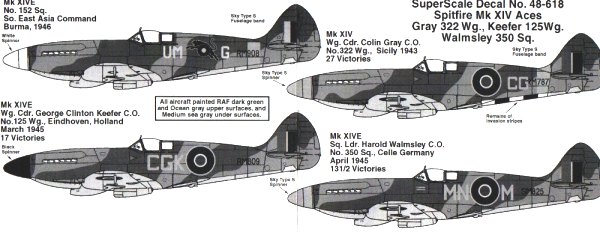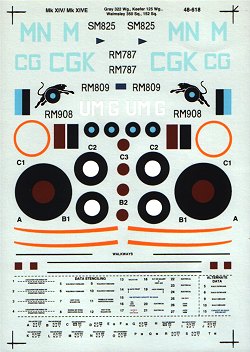
|
Sheet # |
Superscale 48-618: Spitfire XIV Aces |
|
Price: |
? |
|
Units: |
Various RAF |
|
Review By: |
|
|
Notes: |

This sheet offers four examples of the Griffon-engined Spitfire XIV, all being high-backed versions in dark green and ocean grey. First is the well-known Mk XIVe UM-G of 152 Sqn in Burma, with the South-East Asia Command (SEAC) all-blue roundels and a leaping panther design on the fuselage.
Next is a Mk XIV flown by Wing Commander Colin Grey of 322 Wing in Sicily, 1943. The location and year must be mistaken since to my knowledge Mk XIVs only came into service in 1944, and moreover this plane has D-Day invasion stripes on the fuselage underside.
 Then there are two more Mk XIVe – one flown by Wing Commander George
Keefer, CO of 125 Wing in Holland, March 1945, and another by Squadron
Leader Harold Walmsley of 350 Sqn in Germany, April 1945. Grey and Keefer
have the personalised fuselage codes which were the privilege of RAF wing
commanders.
Then there are two more Mk XIVe – one flown by Wing Commander George
Keefer, CO of 125 Wing in Holland, March 1945, and another by Squadron
Leader Harold Walmsley of 350 Sqn in Germany, April 1945. Grey and Keefer
have the personalised fuselage codes which were the privilege of RAF wing
commanders.
The decals are well printed and in perfect register. There is a full set of stencils and one set of European-style and SEAC roundels. A set of yellow wing leading edges for the European aircraft are included as decals (the yellow is the correct shade, even though it appears deep orange in the scanned image). Fuselage lettering for the European aircraft are printed in an incorrect bluish colour but they are repeated in the correct sky colour in a small additional sheet, which is not shown here.
The instructions list references and they should be checked if at all possible, because the sheet gives limited information on each aircraft. There are only port side views, for instance. And there is no indication of whether Colin Grey’s machine was a XIVc or a XIVe. These variants had different configurations of wing armament.
Also, the 152 Squadron machine is commonly portrayed as having cropped wing-tips and white SEAC bands on the wings and tailplanes, but none of this is indicated in the instructions. This plane probably had a different camouflage pattern from the others as a result of the large European-style roundels being overpainted with dark green prior to the application of SEAC markings. This would have been particularly evident on the wings. The side view does show a roundish bulge in the camouflage pattern where the Type C1 roundel would have been, but again there is no further information.
The location of the stencils is plotted on a drawing of a Spitfire IX, which leaves me wondering whether they are correct for this variant rather than the XIV. For instance, there are “100 Octane” notices for the fuselage petrol tank but not for the additional tanks which were installed in the wing leading edges of the XIV.
If you would like your product reviewed fairly and quickly by a site that has over 250,000 visits a month, please contact me or see other details in the Note to Contributors.